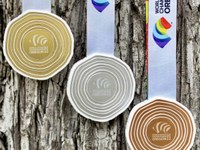Creating Custom Trophies: 3D Printing is Elevating the Awards Industry
3D printing has indeed had a significant impact on the trophy industry, revolutionising the way trophies are designed, manufactured, and customised. Here are some ways in which 3D printing has changed the face of the trophy industry:
Design Freedom: 3D printing allows trophy designers to unleash their creativity and push the boundaries of traditional trophy design. With 3D modeling software, intricate and complex designs can be created, including unusual shapes and fine details,that were previously challenging to achieve using traditional manufacturing methods.
Customisation: 3D printing enables personalised and unique trophy designs. Customisation options such as adding names, logos, or specific details for individual recipients can be easily incorporated into the design. This flexibility allows for a more personalised and memorable trophy experience.
Rapid Prototyping: Traditional trophy manufacturing methods often require creating molds or casting, which can be time-consuming and expensive. With 3D printing, trophies can be rapidly prototyped and iterated upon quickly. This enables designers to refine their designs and make modifications before the final production, saving time and costs.
Small Batch Production: 3D printing allows for efficient small-batch production. In the past, producing a small number of trophies using traditional methods could be economically unviable. However, with 3D printing, trophies can be manufactured on demand without the need for costly setup or tooling. This flexibility makes it feasible to produce trophies in small quantities, catering to specific events or occasions.
Material Variety: 3D printing offers a wide range of material options for trophy production, including various metals, plastics, resins, and even composite materials. This versatility allows for the creation of trophies with different aesthetic and functional properties, adding to the overall appeal and uniqueness of the trophies.
Innovation and Experimentation: 3D printing encourages innovation and experimentation within the trophy industry. Designers and manufacturers can explore new concepts, shapes, and materials, leading to the creation of unconventional and eye-catching trophy designs that were previously unexplored.
Overall, 3D printing has provided the trophy industry with greater design freedom, customisation options, cost efficiency, and the ability to produce trophies in small quantities. These advancements have transformed the industry, making it more accessible than ever before.
To find out more about 3D printing visit: www.mipequeñafabrica.com



